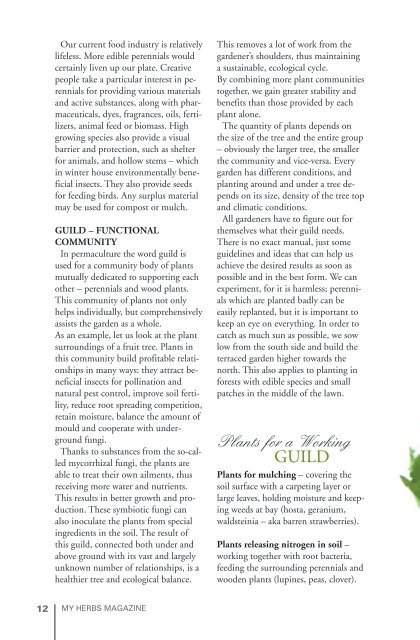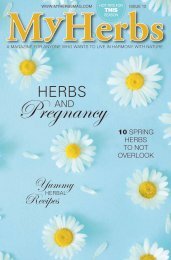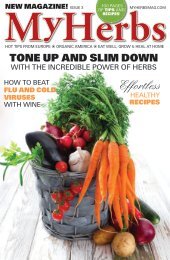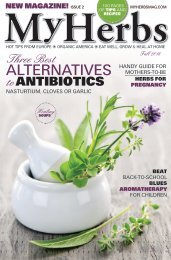MY HERBS #1
Find out more on MYHERBS-STORE.COM. My Herbs is a special quarterly publication for anyone who is interested in alternative cooking, home grown herbs, and traditional or complementary medicine or healing methods, simply for everyone who wants to live in harmony with nature.
Find out more on MYHERBS-STORE.COM.
My Herbs is a special quarterly publication for anyone who is interested in alternative cooking, home grown herbs, and traditional or complementary medicine or healing methods, simply for everyone who wants to live in harmony with nature.
Create successful ePaper yourself
Turn your PDF publications into a flip-book with our unique Google optimized e-Paper software.
Our current food industry is relatively<br />
lifeless. More edible perennials would<br />
certainly liven up our plate. Creative<br />
people take a particular interest in perennials<br />
for providing various materials<br />
and active substances, along with pharmaceuticals,<br />
dyes, fragrances, oils, fertilizers,<br />
animal feed or biomass. High<br />
growing species also provide a visual<br />
barrier and protection, such as shelter<br />
for animals, and hollow stems – which<br />
in winter house environmentally beneficial<br />
insects. They also provide seeds<br />
for feeding birds. Any surplus material<br />
may be used for compost or mulch.<br />
GUILD – FUNCTIONAL<br />
COMMUNITY<br />
In permaculture the word guild is<br />
used for a community body of plants<br />
mutually dedicated to supporting each<br />
other – perennials and wood plants.<br />
This community of plants not only<br />
helps individually, but comprehensively<br />
assists the garden as a whole.<br />
As an example, let us look at the plant<br />
surroundings of a fruit tree. Plants in<br />
this community build profitable relationships<br />
in many ways: they attract beneficial<br />
insects for pollination and<br />
natural pest control, improve soil fertility,<br />
reduce root spreading competition,<br />
retain moisture, balance the amount of<br />
mould and cooperate with underground<br />
fungi.<br />
Thanks to substances from the so-called<br />
mycorrhizal fungi, the plants are<br />
able to treat their own ailments, thus<br />
receiving more water and nutrients.<br />
This results in better growth and production.<br />
These symbiotic fungi can<br />
also inoculate the plants from special<br />
ingredients in the soil. The result of<br />
this guild, connected both under and<br />
above ground with its vast and largely<br />
unknown number of relationships, is a<br />
healthier tree and ecological balance.<br />
This removes a lot of work from the<br />
gardener’s shoulders, thus maintaining<br />
a sustainable, ecological cycle.<br />
By combining more plant communities<br />
together, we gain greater stability and<br />
benefits than those provided by each<br />
plant alone.<br />
The quantity of plants depends on<br />
the size of the tree and the entire group<br />
– obviously the larger tree, the smaller<br />
the community and vice-versa. Every<br />
garden has different conditions, and<br />
planting around and under a tree depends<br />
on its size, density of the tree top<br />
and climatic conditions.<br />
All gardeners have to figure out for<br />
themselves what their guild needs.<br />
There is no exact manual, just some<br />
guidelines and ideas that can help us<br />
achieve the desired results as soon as<br />
possible and in the best form. We can<br />
experiment, for it is harmless; perennials<br />
which are planted badly can be<br />
easily replanted, but it is important to<br />
keep an eye on everything. In order to<br />
catch as much sun as possible, we sow<br />
low from the south side and build the<br />
terraced garden higher towards the<br />
north. This also applies to planting in<br />
forests with edible species and small<br />
patches in the middle of the lawn.<br />
Plants for a Working<br />
GUILD<br />
Plants for mulching – covering the<br />
soil surface with a carpeting layer or<br />
large leaves, holding moisture and keeping<br />
weeds at bay (hosta, geranium,<br />
waldsteinia – aka barren strawberries).<br />
Plants releasing nitrogen in soil –<br />
working together with root bacteria,<br />
feeding the surrounding perennials and<br />
wooden plants (lupines, peas, clover).<br />
12 <strong>MY</strong> <strong>HERBS</strong> MAGAZINE












